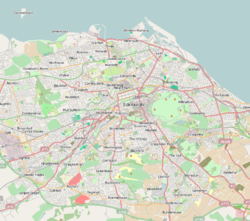
Midlothian is a historic county, registration county, lieutenancy area and one of 32 council areas of Scotland used for local government. Midlothian lies in the east-central Lowlands, bordering the City of Edinburgh council area, East Lothian and the Scottish Borders.

Lothian is a region of the Scottish Lowlands, lying between the southern shore of the Firth of Forth and the Lammermuir Hills and the Moorfoot Hills. The principal settlement is the Scottish capital, Edinburgh, while other significant towns include Livingston, Linlithgow, Bathgate, Queensferry, Dalkeith, Bonnyrigg, Penicuik, Musselburgh, Prestonpans, Tranent, North Berwick, Dunbar, Whitburn and Haddington.

Haymarket is an area of Edinburgh, Scotland. It is in the west of the city centre and is the junction of several main roads, notably Dalry Road, Corstorphine Road, and Shandwick Place. Haymarket contains a number of pubs, cafés and restaurants.

David BryceFRSE FRIBA RSA was a Scottish architect.
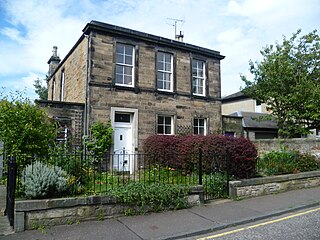
Sciennes is a district of Edinburgh, Scotland, situated approximately 2 kilometres south of the city centre. It is a mainly residential district, although it is also well-known as the site of the former Royal Hospital for Sick Children. Most of its housing stock consists of terraces of four-storey Victorian tenements. The district is popular with students, thanks to its proximity to the University of Edinburgh. Its early history is linked to the presence in the area of the 16th-century Convent of St Catherine of Scienna, from which the district derives its name.

Newington is a neighbourhood of southern Edinburgh, Scotland. Developed from the early 19th century, it is an affluent, predominantly residential area.
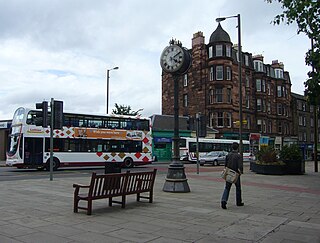
Morningside is a district and former village in the south of Edinburgh, Scotland. It lies alongside the main arterial Morningside Road, part of an ancient route from Edinburgh to the south west of Scotland. The original village served several farms and estates in the area. In the 19th century, it developed as a residential suburb, its growth being stimulated by the arrival of a railway service and other transport improvements.

Lothian and Borders Police was the territorial police force for the Scottish council areas of the City of Edinburgh, East Lothian, Midlothian, Scottish Borders and West Lothian between 1975 and 2013. The force's headquarters were in Fettes Avenue, Edinburgh.
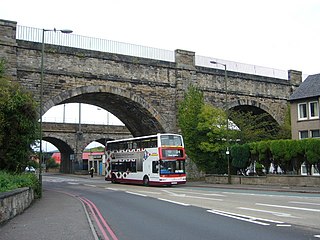
Longstone is a suburb of Edinburgh in Scotland. The area is primarily residential in nature, although the area includes several small shops, eateries and supermarkets, as well as one of the main bus depots for the city's buses. The population of Longstone was 4,678 in 2019.

Linlithgow is a town in West Lothian, Scotland. It was historically West Lothian's county town, reflected in the county's historical name of Linlithgowshire. An ancient town, it lies in the Central Belt on a historic route between Edinburgh and Falkirk beside Linlithgow Loch. The town is situated approximately 20 miles (32 km) west of Edinburgh.
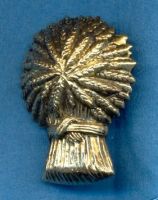
The Lothians and Border Horse was a Yeomanry regiment, part of the British Territorial Army. It was ranked 36th in the Yeomanry order of precedence and was based in the Scottish Lowland area, recruiting in the Lothians – East Lothian (Haddingtonshire), Midlothian (Edinburghshire), and West Lothian (Linlithgowshire) – and along the border with England, particularly Berwickshire. It amalgamated with the Lanarkshire Yeomanry and the Queen's Own Royal Glasgow Yeomanry to form the Queen's Own Lowland Yeomanry in 1956.

The Queen's Hall is a performance venue in the Southside, Edinburgh, Scotland. The building opened in 1824 as Hope Park Chapel and reopened as the Queen's Hall in 1979.
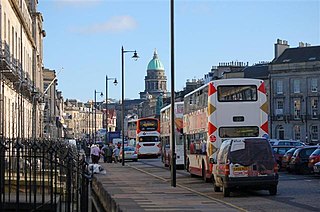
The West End is an affluent district of Edinburgh, Scotland, which along with the rest of the New Town and Old Town forms central Edinburgh, and Edinburgh's UNESCO World Heritage Site. The area boasts several of the city's hotels, restaurants, independent shops, offices and arts venues, including the Edinburgh Filmhouse, Edinburgh International Conference Centre and the Caledonian Hotel. The area also hosts art festivals and crafts fairs.

The City of Edinburgh Council is the local government authority covering the City of Edinburgh council area. Almost half of the council area is the area of Edinburgh, capital of Scotland. With a population of 526,470 in mid-2019, it is the second most populous local authority area in Scotland.

The Dalmeny Street drill hall in Edinburgh, was built as a military drill hall in 1901, and between 2003 and 2010 was redeveloped as community arts and education centre under the name TheOut of the Blue Drill Hall. The drill hall is protected as a category A listed building.

The Scottish and North Irish Yeomanry (SNIY) is a reserve light cavalry regiment created in 2014 as part of the restructuring of the British Army's Army Reserve. It is operationally paired with the Royal Scots Dragoon Guards, based at Leuchars Station in Fife, Scotland. The regiment has numerous squadrons across Scotland and Northern Ireland.

The Yorkhill Parade drill hall is a former military installation in Glasgow.

The High Street drill hall was a military installation in Dunkeld.
The Forth Brigade was a Scottish infantry formation of Britain's Volunteer Force from 1888 to 1902.

The Highland Church was a Gaelic-speaking congregation of the Church of Scotland, based in Tollcross, Edinburgh. Formed by the union of St Oran's Church and St Columba's Gaelic Church in 1948, the congregation continued united with Tolbooth St John's in 1956.

